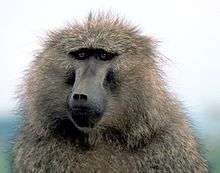Archonta
The Archonta are a group of mammals, considered a superorder in some classifications, which consists of these orders:
- Primates
- Plesiadapiformes (extinct primate-like archontans)
- Scandentia (treeshrews)
- Dermoptera (colugos)
| Archonta | |
|---|---|
 | |
| Olive baboon | |
| Scientific classification | |
| Kingdom: | |
| Phylum: | |
| Class: | |
| Subclass: | |
| Superorder: | Archonta (disputed) |
| Orders | |
| |
While bats were traditionally included in the Archonta, recent genetic analysis has suggested that bats actually belong in Laurasiatheria.[1] A revised category, Euarchonta, excluding bats, has been proposed.[2][3]
This taxon may have arisen in the Early Cretaceous (more than 100 million years ago), so other models may explain mammalian evolution besides an explosive radiation from a single surviving lineage following the Cretaceous-Paleogene extinction of the Mesozoic megafauna,[4] such as a series of prior radiations related to the breakup of Gondwana and Laurasia allowing for more survivors.[5][6]
References
- Van de Bussche, R. A.; Hoofer, S. R. (2004). "Phylogenetic relationships among recent chiropteran families and the importance of choosing appropriate out-group taxa". Journal of Mammalogy. 85 (2): 321–330. doi:10.1644/1545-1542(2004)085<0321:Prarcf>2.0.Co;2.
- Adkins, RM; Honeycutt, RL (Nov 15, 1991). "Molecular phylogeny of the superorder Archonta". Proceedings of the National Academy of Sciences of the United States of America. 88 (22): 10317–21. doi:10.1073/pnas.88.22.10317. PMC 52919. PMID 1658802.
- Springer, MS; Stanhope, MJ; Madsen, O; de Jong, WW (August 2004). "Molecules consolidate the placental mammal tree". Trends in Ecology & Evolution. 19 (8): 430–8. doi:10.1016/j.tree.2004.05.006. PMID 16701301.
- Penny, David; Phillips, Matthew J. (October 2004). "The rise of birds and mammals: are microevolutionary processes sufficient for macroevolution?". Trends in Ecology & Evolution. 19 (10): 516–522. doi:10.1016/j.tree.2004.07.015. PMID 16701316.
- Hedges, S. Blair; Kumar, Sudhir (30 April 1998). "A molecular timescale for vertebrate evolution" (PDF). Nature. 392 (6679): 917–920. doi:10.1038/31927. PMID 9582070.
- Hedges, SB; Parker, PH; Sibley, CG; Kumar, S (May 16, 1996). "Continental breakup and the ordinal diversification of birds and mammals" (PDF). Nature. 381 (6579): 226–9. doi:10.1038/381226a0. PMID 8622763. Archived from the original (PDF) on December 19, 2013. Retrieved December 18, 2013.
This article is issued from Wikipedia. The text is licensed under Creative Commons - Attribution - Sharealike. Additional terms may apply for the media files.